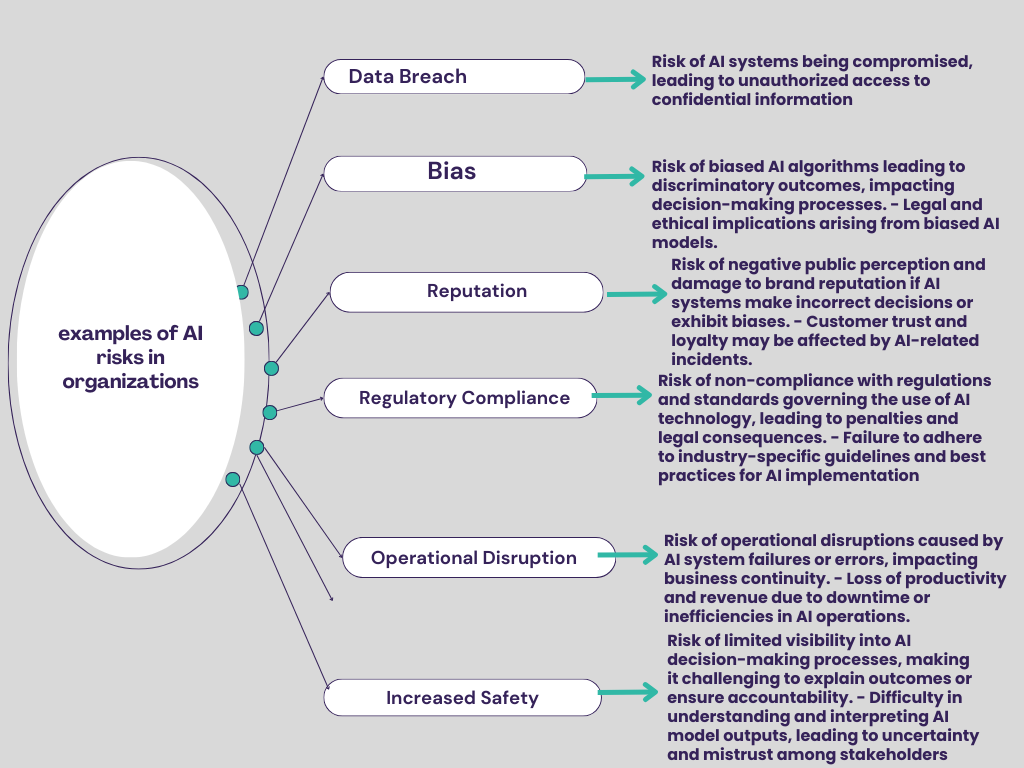AI Governance: Implementing Strong AI Governance
In today’s dynamic technological landscape, Artificial Intelligence (AI) stands out as a transformative force revolutionizing organizational operations and fostering innovation and efficiency. However, this disruptive technology brings with it a spectrum of potential risks that demand meticulous attention and strategic planning. Therefore, prioritizing AI governance is essential for organizations to integrate AI systems seamlessly into their operations and drive sustainable growth.
How is AI Governance critical?

Effective Risk Management in AI Governance:
Effective risk management in AI governance is crucial in today’s technologically advanced world, where artificial intelligence systems are gaining more autonomy and connectivity. As organizations rely more on AI technologies to drive business operations, they face a variety of risks, such as data breaches, system failures, and algorithmic bias, that can have significant financial, legal, and reputational consequences.

To address these risks, companies must implement robust AI governance frameworks that incorporate comprehensive risk management practices. One key aspect of this is conducting thorough risk assessments to identify potential vulnerabilities in AI systems and processes. This involves analyzing the various components of AI deployment, including data sources, algorithms, models, and decision-making processes, to determine where vulnerabilities exist and the potential impact of those vulnerabilities on the organization. Once vulnerabilities are identified, organizations must develop and implement mitigation strategies to reduce the likelihood and impact of these risks. This may involve implementing security measures to protect data, improving system reliability and resilience to prevent failures, and addressing algorithmic bias through enhanced transparency and accountability.
By proactively managing risks through effective AI governance practices, organizations can better protect their operations and build trust with stakeholders. This approach not only helps to safeguard against potential harm but also enables organizations to leverage the full potential of AI technologies in a responsible and ethical manner.
Driving Advancements through AI Governance:
Implementing strong governance structures is imperative to effectively manage AI’s advancements in organizations.
Here is a comprehensive checklist to ensure sound AI governance within your organization:
- Establish Clear Governance Structures: – Define roles and responsibilities for AI governance. – Identify key stakeholders involved in decision-making processes related to AI.
- Develop an AI Strategy: – Align AI initiatives with the organization’s strategic objectives. – Define clear goals and KPIs to monitor the success of AI projects. Risk Management: – Conduct risk assessments to identify potential AI implementation risks. – Develop mitigation strategies to address identified risks and ensure business continuity.
- Data Governance: – Implement data quality standards and ensure data integrity for AI models. – Enforce data management policies governing data usage, sharing, and access.
- Model Governance: – Establish processes for model development, deployment, and monitoring. – Define guidelines for model validation and testing for accuracy and reliability.
- Ethical AI Principles: – Set ethical guidelines for AI development and deployment. – Ensure transparent and fair AI algorithms to prevent bias and discrimination. Compliance and Regulatory Requirements: – Stay informed about relevant regulations and compliance standards related to AI. – Conduct compliance training programs to educate employees on AI regulations and best practices.
- AI Security Awareness Training: – Invest in security measures like encryption and access controls to protect data. – Provide AI security and compliance awareness training to employees to promote a culture of security.
- Security Measures: – Implement security protocols to safeguard AI systems and data from cyber threats. – Conduct regular security audits to identify vulnerabilities and ensure data security.
- Monitoring and Evaluation: – Establish monitoring mechanisms to track AI system performance· – Conduct regular evaluations to assess the impact of AI initiatives on business outcomes.
- Continuous Learning and Improvement: Foster a culture of continuous learning and improvement around AI technologies. – Provide training opportunities for employees to enhance their AI skills and knowledge.
By following this checklist, organizations can ensure effective governance of AI technologies, mitigate risks, and drive successful AI adoption to achieve their business objectives.
Contact us:
info@cyberdsc.com +1(213)-759-8010
https://www.linkedin.com/in/sofia-nabiha-herradi-ll-b-j-d-cism-cipp-us-cipp-e-cmmc-ccp-5b7063174

Pingback: AI Security Governance Awareness Training